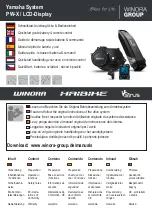
13
E
ngl
is
h
2
1
x
x
x
1. Hold the down tube (W2) with one hand, and
lift the bicycle so that the front wheel (U) leaves
the ground.
2. Turn the handlebars from side to side with your
other hand.
-
If this movement feels heavy and you experience
obvious resistance, the headset bearings (N1 and
N2) are either faulty or have been overtightened,
which must be corrected.
-
If the side-to-side movement is easy and does not
involve any resistance, return the front wheel to
the ground and proceed to step 3.
3. Cup one hand around the protective cap of the bearing
and the upper part of the head tube (W1). With your
free hand, squeeze the brake lever for the front rim
brake so that it locks completely.
4. Move the bicycle forwards/backwards in short jerking
movements, and feel and listen to check there is no
free movement.
-
If you notice any free movement, this must be
corrected.
-
If you cannot detect any free movement,
the headset bearings are correctly tightened.
3. Select an angle.
Angling and centring the handlebars
1. Loosen the four 4 mm
socket head screws
(12) in the front plate.
2. Twist the handlebars
up/down to the desired
angle and make sure
that the stem is centred
on the handlebars.
3. Tighten the screws crosswise by degrees.
4. When tightening the
screws, a little at a
time, make sure that
the gap between the
front plate and the main
body of the stem is the
same at the top and
the bottom.
Headset
Warning:
• Beneath the cover (N3) in the centre of the steerer
tube clamp there is a screw that
should only be used
to adjust the headset, which requires specialist
expertise
.
•
The screw (N8)
of the steerer tube clamp
should
only be touched when adjusting the headset
and
the angle of the stem,
which requires specialist
expertise
.
Checking the headset
4. First tighten the grub
screw (N6) and then
the socket head screw
(N7).
Содержание 31-9779
Страница 2: ......














































